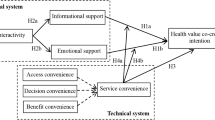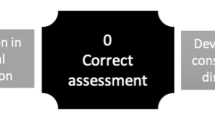Abstract
Evidence from relevant studies show that the use of social networking sites or Web 2.0 portals in health care provide huge potential to transform traditional health care services, generating great collaboration, participation and openness. However, challenges of employing Web 2.0 for health care still exit. This empirical study uses semi-structured interview approach to explore health care professionals’ attitudes towards using Web 2.0 portals for health care, especially focusing on specific social networking sites for chronic health care in China. Results present a range of positive attitudes of using the social networking sites to health professionals’ clinical practice. Meanwhile, the opportunities and barriers related to use of such social networking sites into clinical practice are presented and discussed.
Chapter PDF
Similar content being viewed by others
References
Eysenbach, G.: From intermediation to disintermediation and apomediation: new models for consumers to access and assess the credibility of health information in the age of Web 2.0. Stud. Health Technol. Inform. 129(pt. 1), 162–166 (2007)
Eysenbach, G.: Medicine 2.0: social networking, collaboration, participation, apomediation, and openness. J. Med. Internet Res. 10(3), 22 (2008)
Zrebiec, J.F.: Internet communities: do they improve coping with diabetes? Diabetes Educ. 31(6), 825–828, 830–832, 834, 836 (2005)
Nordqvist, C., Hanberger, L., Timpka, T., Nordfeldt, S.: Health Professionals’ Attitudes Towards Using a Web 2.0 Portal for Child and Adolescent Diabetes Care: Qualitative Study. J. Med. Internet Res. 11(2), 240–247 (2009)
Booth, R.G.: Educating the future eHealth professional nurse. Int. J. Nurs. Educ. Scholarsh. 3, Article 13 (2006)
Eysenbach, G.: An Ontology of Quality Initiatives and a Model for Decentralized, Collaborative Quality Management on the (Semantic) World Wide Web. J. Med. Internet Res. 3(4), 34 (2001)
Kerr, C., Murray, E., Stevenson, F., Gore, C., Nazareth, I.: Internet interventions for long-term conditions: patient and caregiver quality criteria. J. Med. Internet Res. 8(3), 13 (2006)
Eysenbach, G., Köhler, C., Yihune, G., Lampe, K., Cross, P., Brickley, D.: A framework for improving the quality of health information on the world-wide-web and bettering public (e-)health: the MedCERTAIN approach. Stud. Health Technol. Inform. 84(pt. 2), 1450–1454 (2001)
Wigand, R.T., Benjamin, R.I., Birkland: Web 2.0 and beyond: implications for electronic commerce. Presented at the 10th International Conference on Electronic Commerce (2008)
Van De Belt, T.H., Engelen, L.J., Berben, S.A., Schoonhoven, L.: Definition of Health 2.0 and Medicine 2.0: A Systematic Review. J. Med. Internet Res. 12(2), 18 (2010)
Hughes, B., Joshi, I., Wareham, J.: Health 2.0 and Medicine 2.0: Tensions and Controversies in the Field. J. Med. Internet Res. 10(3), 23 (2008)
Juzwishin, D.W.M.: Political, policy and social barriers to health system interoperability: Emerging opportunities of Web 2.0 and 3.0. Healthc. Manage. Forum 22(4), 6–10 (2009)
Jackson, C.L., Bolen, S., Brancati, F.L., Batts-Turner, M.L., Gary, T.L.: A systematic review of interactive computer-assisted technology in diabetes care. Interactive information technology in diabetes care. J. Gen. Intern. Med. 21(2), 105–110 (2006)
Harno, K., Kauppinen-Mäkelin, R., Syrjäläinen, J.: Managing diabetes care using an integrated regional e-health approach. J. Telemed. Telecare 12(suppl. 1), 13–15 (2006)
McMahon, G.T., Gomes, H.E., Hickson Hohne, S., Hu, T.M.-J., Levine, B.A., Conlin, P.R.: Web-based care management in patients with poorly controlled diabetes. Diabetes Care 28(7), 1624–1629 (2005)
Hoey, H., Aanstoot, H.J., Chiarelli, F., Daneman, D., Danne, T., Dorchy, H., Fitzgerald, M., Garandeau, P., Greene, S., Holl, R., Hougaard, P., Kaprio, E., Kocova, M., Lynggaard, H., Martul, P., Matsuura, N., McGee, H.M., Mortensen, H.B., Robertson, K., Schoenle, E., Sovik, O., Swift, P., Tsou, R.M., Vanelli, M., Aman, J.: Good metabolic control is associated with better quality of life in 2,101 adolescents with type 1 diabetes. Diabetes Care 24(11), 1923–1928 (2001)
Nordfeldt, S., Johansson, C., Carlsson, E., Hammersjö, J.-A.: Use of the Internet to search for information in type 1 diabetes children and adolescents: a cross-sectional study. Technol. Health Care Off. J. Eur. Soc. Eng. Med. 13(1), 67–74 (2005)
Falkman, G., Gustafsson, M., Jontell, M., Torgersson, O.: SOMWeb: A Semantic Web-Based System for Supporting Collaboration of Distributed Medical Communities of Practice. J. Med. Internet Res. 10(3), 25 (2008)
Eysenbach, G., Diepgen, T.L.: Towards quality management of medical information on the internet: evaluation, labelling, and filtering of information. BMJ 317(7171), 1496–1500 (1998)
Eysenbach, G.: Credibility of Health Information and Digital Media: New Perspectives and Implications for Youth. In: Digital Media, Youth, and Credibility. The John D. and Catherine T. MacArthur Foundation Series on Digital Media and Learning (2008)
Brummaier, T., Pohanka, E., Studnicka-Benke, A., Pieringer, H.: Using cyclophosphamide in inflammatory rheumatic diseases. Eur. J. Intern. Med. 24(7), 590–596 (2013)
Author information
Authors and Affiliations
Editor information
Editors and Affiliations
Rights and permissions
Copyright information
© 2014 Springer International Publishing Switzerland
About this paper
Cite this paper
Huang, Z., Gai, N. (2014). Exploring Health Care Professionals’ Attitudes of Using Social Networking Sites for Health Care: An Empirical Study. In: Meiselwitz, G. (eds) Social Computing and Social Media. SCSM 2014. Lecture Notes in Computer Science, vol 8531. Springer, Cham. https://doi.org/10.1007/978-3-319-07632-4_35
Download citation
DOI: https://doi.org/10.1007/978-3-319-07632-4_35
Publisher Name: Springer, Cham
Print ISBN: 978-3-319-07631-7
Online ISBN: 978-3-319-07632-4
eBook Packages: Computer ScienceComputer Science (R0)




